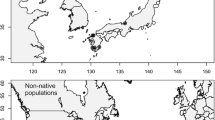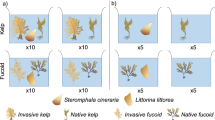Abstract
Experiments were conducted to determine the forces required for two limpet species to remove tissue from three different types of algae. This was done by using the radulae of the limpets, mimicking the way they use this feeding apparatus. For both Acmaea mitra Rathke (a specialist herbivore) and Notoacmea scutum (Rathke) (a generalist herbivore), Iridaea cordata (Turn.) Bory (a thin, bladed red alga) required the most force; Hedophyllum sessile (C.Ag.) Setch. (a thick, bladed brown alga) the next; and Pseudolithophyllum whidbeyensi (a crustose, calcified alga) required the least amount of force for tissue removal. These results are the inverse of the predictions made by current functional form and functional group models which use the thallus form as a predictor of herbivore resistance. Thallus form alone is a poor predictor of structural resistance to molluscan feeding; the material properties of the alga, the feeding apparatus of the herbivore, and the mode of feeding all must be considered.
Similar content being viewed by others
Literature cited
Barnes, R. D.: Invertebrate zoology, 1089 pp. Philadelphia. Saunders College 1980
Borowitzka, M. A.: Mechanisms in algal calcification. Prog. phycol. Res. 1, 137–177 (1982)
Branch, G. M.: The biology of limpets: physical factors, energy flow, and ecological interactions. Oceaogr. mar. Biol. A. Rev. 19, 235–280 (1981)
Fretter, V. and A. Graham: British prosobranch molluscs. Their functional anatomy and ecology, 755 pp. London: Adlard and Son, Ltd. Bartholomew Press 1962
Gordon, J. E.: The new science of strong materials, 287 pp. Harmondsworth, UK: Penguin Books Ltd. 1968
Hickman, C. S.: Gastropod radulae and the assessment of form in evolutionary paleontology. Paleobiology 6, 276–294 (1980)
Littler, M. M. and D. S. Littler: The evolution of thallus form and survival strategies in benthic marine macroalgae: field and laboratory tests of a functional form model. Am. Nat. 116, 25–44 (1980)
Lowenstam, H. A.: Goethite in radular teeth of recent marine gastropods. Science, N.Y. 137, 279–280 (1962)
Lowenstam, H. A.: Minerals formed by organisms. Science, N.Y. 211, 1126–1130 (1981)
Mulhearn, T. O. and L. E. Samules: The abrasion of metals: a model of the process. Wear 5, 478–498 (1962)
Runham, N. W. and P. R. Thornton: Mechanical wear of the gastropod radula: scanning electron microscope study. J. Zool. Lond. 153, 445–452 (1967)
Runham, N. W., P. R. Thornton, D. A. Shaw and R. C. Wayte: The mineralization and hardness of the radular teeth of the limpet Patella vulgata L. Z. Zellforsch. 99, 608–626 (1969)
Samules, L. E.: The mechanics of abrasive machining. Sci. Am. 239, 132–153 (1978)
Steneck, R. S. and L. Watling: Feeding capabilities of herbivorous molluscs: a functional group approach. Mar. Biol. 68, 299–319 (1982)
Vincent, J. F. V.: Structural biomaterials, 206 pp. New York: Halsted Press 1982
Wainwright, S. A., W. D. Biggs, J. D. Currey and J. M. Gosline: Mechanical design in organisms, 423 pp. New York: Wiley Press 1975
Author information
Authors and Affiliations
Additional information
Communicated by J. M. Lawrence, Tampa
Rights and permissions
About this article
Cite this article
Padilla, D.K. Structural resistance of algae to herbivores. Marine Biology 90, 103–109 (1985). https://doi.org/10.1007/BF00428220
Accepted:
Issue Date:
DOI: https://doi.org/10.1007/BF00428220




